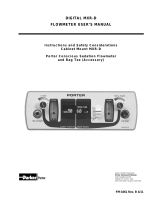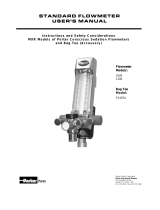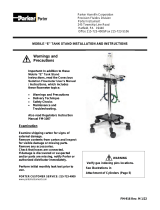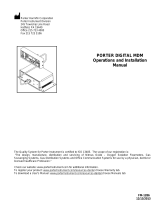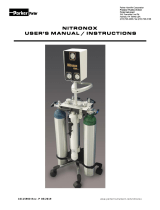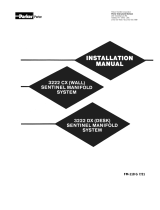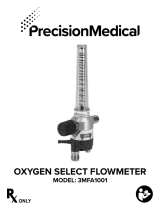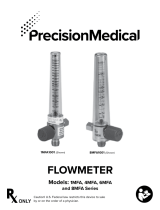Page is loading ...

Porter Conscious Sedation Flowmeters
and Bag Tee (Accessory)
Instructions and Safety Considerations
This product complies with the Medical Device Directive (93 / 42 / EEC).
A “Declaration of Conformity” in accordance with the directive has been made and is on file.
European Communities should contact the Authorized Representative listed below regarding any
Medical Device Directive (MDD) inquiries.
Contact Name:
Parker Hannifin Manufacturing Sarl
Mailing Address:
Via privata Archimede 1, 20094 Corsico, Italy
Phone:
+44 (0) 1271-313131
The Quality System for Porter Instrument is certified to ISO 13485. The scope of our registration is:
“The design, manufacture, distribution and servicing of Nitrous Oxide – Oxygen Sedation Flowmeters, Gas
Scavenging Systems, Gas Distribution Systems and Office Communication Systems for use by a physician,
dentist or licensed healthcare Professional.”
Check our website: www.porterinstrument.com for additional information.
FM-825-CE-English Rev. N 1/2022
MXR MODELS / REF:
C3000
C3050
DTL-146W
DTL-164W
Bag Tee Accessory:
P1407E

1
IMPORTANT:
READ MANUAL COMPLETELY BEFORE OPERATING THIS DEVICE
Basic delivery technique is described. Also, this manual contains instructions on periodically required
checks to be performed by the user. These checks are necessary to insure the proper performance of
this device and its safety features. Retain this manual for future reference.
WARNINGS AND PRECAUTIONS
These warnings and precautions are to help you to
understand how to safely operate the MXR
Flowmeter. A WARNING alerts you to a possible
hazard to people. A CAUTION alerts you to the
possibility of equipment damage.
WARNING: Do not use this device for the
administration of general anesthesia or as a part of,
or in conjunction with, a general anesthesia
administration system.
WARNING: Workers are exposed to N2O during
administration of N2O/O2 conscious sedation
analgesia. NIOSH has recommended that
exposures should be minimized. Contact NIOSH (1-
800-35-NIOSH) to receive NIOSH Publications on
Control of Nitrous Oxide in Dental Operatories.
Exposure can be minimized by effective controls.
National Institute for Occupational Safety and Health
(NIOSH) publications state that controls, including
System Maintenance, Ventilation and Work
Practices can effectively reduce N2O concentrations
in patient procedures. Your flowmeter accessory
Porter scavenger system is an important part of the
system of controls.
WARNING: Porter Instrument equipment utilizes the
cross+protection system. The flexible hose and
connectors that connect to the flowmeter are
diameter indexed; 3/8” O.D. for Nitrous Oxide and ½”
for Oxygen. The cross+protection system is
designed to prevent misconnection of Oxygen and
Nitrous Oxide piping. DO NOT ATTEMPT TO
CHANGE THE DIAMETERS OR CONNECTORS
OF THE FLOWMETER! Tampering with the
cross+protection system constitutes acceptance of
liability by the installer. For your own protection, as
well as that of the Doctor and the patients, use 3/8”
O.D. tubing for all Nitrous Oxide lines and ½” O.D.
tubing for all Oxygen lines.
To assure safe operation and conformation to local
fire codes, all Porter Instrument flowmeter systems
are designed to be used with sedation delivery
systems mounted inside walls and they meet or
exceed the guidelines established by the National
Fire Protection Association for Nonflammable
Medical Gas Systems, NFPA 99. Copies of NFPA 99
or portions thereof may be obtained by writing to:
National Fire Protection Association, Batterymarch
Park, Quincy, MA 02269-9904; or call 1-800-344-
3555
WARNING: New or modified installations - properly
connected gas pipelines are absolutely essential
to patient safety. The authorized distributor or
contractor should provide written documentation that
all gas pipelines are connected properly and that the
system has been pressure tested prior to use. While
this is a good business practice, it is important that
the user verify by their own test, independent of the
authorized distributor or contractor, that all gas
pipelines are connected correctly prior to using the
system. The ultimate responsibility of assuring
that lines are not crossed rests with the user.
WARNING: During any power outage, remember
to turn OFF the flowmeter and manually turn OFF
the tank valves. With centralized, electrically
powered gas systems, if gas was flowing when the
power went out and the flowmeter is left ON, gas will
be flowing when the power is restored.
CAUTION: This device is for use by or on the order
of a physician, dentist or licensed healthcare
professional.
CAUTION: Always use clean, dry medical grade
gases. Introduction of moisture or other
contaminants into this device may result in defective
operation.
CAUTION: Do not attempt to repair, alter or calibrate
this device. Unauthorized repair, alteration or
misuse of this device is likely to adversely affect the
performance and will void the warranty.
CAUTION: Never oil or grease any part of this
system (minimize fire or explosion potential).

2
2
FIGURE 1 FLOWMETER FEATURES
1. Oxygen Flowmeter Tube indicates the
fl ow of O 2 in L /min ±5%.
2. Nitrous Oxide Flowmeter Tube
in dicat es fl ow of N 2O in L/ m in ±5%.
3. Nitrous Oxide Failsafe System. Dual-
se al ox ygen-piloted valve system that
au tomatically maintain s the % N2O
conce ntration set ting with an y chan ge in t he O 2
fl ow o r pr e ssure. N2O flow is prop o rtiona tely
red uced if O 2 is sh ut o ff or the pressure is
red uced ( check befor e each use).
4. Flow Control Knob contro ls the
co mbined flow of O 2 and N2O ( or O 2 flow only
wh en th e Co ncentr a tion Contr ol Knob is set to
0%).
5. Concentration Control Knob contro ls
th e % concen tratio n of N 2O but does not change
th e O2 flo w rate . (70% M a ximum N2O delivery.)
(Check M onthly)
6. Emergency Air Valve a utomaticall y
pr o vides the pat ient wit h amb ient air if gas flow
is inte rrupted . (Che ck Mon thly)
7. Non-Rebreathing Valve guards against
CO2 build-up and rebreathing of used gases.
(Check M onthly)
8. Positive On - Off Switch Redu ces th e
po ssibi lity o f accidentally lea ving the ma chine
ON .
9. Power Flush provides extra delivery of O 2
to the breathing bag. (Check Month ly)
10. O2 Quick Connect ( left sid e of
machine) , facilit ates conne ction of positive
pr e ssure/ deman d valve for emergen cy Ox ygen.
11. Bag Tee Outlet c onnects to fresh gas
tu bing.
12. 3L and 2L Bag Connection
1
2
6
7
5
3
9
12
10
11
8
4

3
INTENDED USE:
Flowmeter for Analgesia
Delivery System
This device is intended for patient use by an attending
physician, dentist or licensed professional properly
trained in its use. Porter Instrument recommends the
user be thoroughly familiar with the use of Nitrous
Oxide - Oxygen Conscious Sedation for patient
analgesia and be properly trained in its administration
prior to using this product. For training requirements
on the administration of Nitrous Oxide - Oxygen
Conscious Sedation, contact the appropriate
regulatory authority in your country, state, or province.
Training is recommended to provide a practical,
hands-on capability and an understanding of the
behavioral aspects of Nitrous Oxide Sedation and will
complement the safety features of this device.
USE SCAVENGING
Monitor for N2O in the patient treatment area to insure
that controls are effective in achieving low levels of
PPM (parts per million) exposure. Contact your Porter
dealer for details on monitors and testing.
GAS SUPPLY CONNECTION
After installation of the flowmeter, connect the nitrous
oxide and oxygen supply lines to the Diameter Indexed
Safety System (DISS) fittings located on the back of
the flowmeter unit. It is important that the regulators
for both gases be set to give pressures in the range of
53 PSIG ±2 PSIG.
Confirm the absence of leaks at pressure connections
on the unit. Bubbles will appear at leaking locations
when a soap / water solution is used. This procedure
is recommended each time a cylinder is changed.
MONTHLY LEAK CHECK (or if connections to
flowmeter are disconnected and then reconnected,
such as after a flowmeter service at the factory or if
the DISS/DISS hose is replaced): Leak test the
flowmeter system for working pressure leaks. After all
hose connections are tightened, turn both control
knobs to the off position and the on/off switch to the off
position. Confirm that the DISS Shut-Off Valves are in
the open position. Pressurize the sedation gas supply
lines with 50 PSI. Observe any pressure decay after
an overnight time period (5 PSI drop allowed).
Monitor O2 gas pressures at the beginning of each
procedure to assure sufficient gas remains in the tank
to complete the procedure.
SAFETY FEATURE CHECKS
IMPORTANT: These are safety features, which
you should routinely check to assure proper function.
If any of these safety features are not functioning
properly, contact your authorized distributor or Porter
Instrument and arrange for the necessary repairs.
Porter Instrument recommends the repairs be made
before reusing the device.
NITROUS OXIDE FAILSAFE SYSTEM
CHECK BEFORE EACH USE
1. Set the right-hand total Flow Control Knob to zero
and set the left-hand Concentration Control Knob
to zero. (See Figure 1-Items 4 and 5: Rotate
control knobs to stop.)
2. Be sure O2 and N2O are connected to your MXR
and line pressure for both gases is 50 PSIG
(which is standard).
3. Turn the Concentration Control Knob to 50%.
There should be no flow of N2O. This is a check
of the static position of the Nitrous Oxide Failsafe
System valve.
NOTE: A momentary low flow of N2O (about 1
L/min for about a second) may be seen if the
Concentration Control Knob is turned to zero
before turning the Flow Control Knob to zero. This
is N2O gas trapped between the Nitrous Oxide
Failsafe System valve and the Concentration
Control Knob valve and is a normal occurrence.
No other N2O flow should be observed.
4. With the Concentration Control Knob still set to
50%, turn the Flow Control Knob to achieve a flow
of 3 to 4 L/min of O2. You should observe an
equal amount of N2O flowing by gradually turning
the Flow Control Knob. (Refer to Monthly
Calibration Check on Page 4, to read ball float on
flowmeter tubes.)
5. Interrupt the flow of O2. This will check the
dynamic status of the Nitrous Oxide Failsafe
System valve. This can be done by either
disconnecting the oxygen hose from the wall or
shutting off the oxygen at the tank. The Nitrous
Oxide flow should drop as the Oxygen flow
decreases, stopping completely before the
Oxygen float drops to zero.
WARNING
If the Nitrous Oxide Failsafe System fails to perform as
indicated, do not use this product prior to repair.
Improper function of this safety feature may permit
Nitrous Oxide to flow independently of the flow control
knob, potentially allowing Nitrous Oxide to flow to the
patient without Oxygen.

4
CONCENTRATION CONTROL KNOB VALVE –
CHECK MONTHLY
Set the Concentration Control Knob to 50%, and Flow
Control Knob to 2 to 3 L/min. The ball indicators will
be at about the same height (If not, refer to Monthly
Calibration Check section for the procedure on
checking the accuracy of the meter.). Turn the
Concentration Control Knob to zero. The N2O flow
should drop to zero. You essentially perform the
check at the end of every procedure when you
oxygenate the patient with 100% O2.
POWER OXYGEN FLUSH
CHECK MONTHLY
(O2 SUPPLY PRESSURE AT 50 PSIG)
Disconnect the corrugated rubber tubing from the bag
tee outlet (Figure 1, Item 11). With both control knob
valves OFF, depress the power (O2) flush button while
blocking the flow from the front of the bag tee. For
proper operation, the gas reservoir bag should fill
within about 5 seconds. Also test for bag / rubber
goods leak following steps 1 through 6.
Quick Test to Check Reservoir Bag / Rubber
Goods for Leaks
1. With the flowmeter, bag tee and Porter rubber
goods in place, remove the nosepiece and one of
the two plastic connectors from the Porter rubber
goods.
2. With the other plastic connector, join the two
duplex hoses together making a closed system.
3. Taking care not to fill the bag too much (bag could
burst), open the oxygen control valve until the
reservoir bag starts to over-inflate or “balloon”,
then close the valve.
4. Observe the reservoir bag for five minutes.
5. The bag should stay inflated. If so, the test has
been successful and there are no excessive leaks.
If the bag does not stay inflated, the reservoir bag
or rubber goods have an excessive leak. Replace
any parts that leak and retest until results are
successful.
6. Disconnect one of the duplex hoses from the
plastic connector and re-install the nosepiece.
BAG TEE
The Bag Tee assembly features a Non-rebreathing
Valve and an Emergency Air Intake located on the
Bag Tee (no carbon dioxide buildup). The emergency
air intake has a valve that allows room air to be
inhaled into the breathing circuit by the patient. A
breathing bag is attached to the metal portion of the
flowmeter.
Bag Tee Installation to Flowmeter: Screw knurled
seal down tight onto flowmeter making sure the rubber
washer is inside the seal nut. When tight, the bag tee
should not rotate.
NON-REBREATHING VALVE
CHECK MONTHLY
With unit turned OFF, disconnect the corrugated rubber
tubing from the Rubber Goods and breathe into the
corrugated tubing connected to the bag tee. You should
not be able to fill the bag with exhalation gas. If the bag
fills, the system’s Non-Rebreathing Valve is not
functioning properly and should be replaced.
EMERGENCY AIR VALVE
CHECK MONTHLY
With unit turned OFF, disconnect the corrugated rubber
tubing from the Rubber Goods and draw air with your
mouth through the corrugated tubing connected to the
bag tee. You should be able to draw ambient air through
the Emergency Air Valve (the gas bag may have to fully
collapse first). Air going through the valve sounds
different than normal gas flow.
MONTHLY CALIBRATION CHECK
The MXR Flowmeter is designed to maintain its
accuracy and performance without routine user
maintenance being required. The flowmeter tubes and
ball floats are very resistant to accuracy changes over
time such that the direct readings of the L/min on the
scales maintain their accuracy. However, the user can
check the relative accuracies of the % concentration and
total flow valve system by performing a simple check.
A calibration check of the % concentration can be done
by setting the % concentration knob to 50% and the flow
control knob to 3 to 4 L/min. Check to see if the tube
readings are within 0.5 L/min of each other. Servicing is
indicated if the readings are out of this tolerance.
NOTE: Adequate and safe conscious sedation can be
achieved even if the % concentration is outside of the
listed tolerance, since tube scale accuracies are
maintained. However, a change in the %
concentration calibration is an indication of overall
flowmeter condition. Porter servicing is available,
including recalibration, pressure testing, internal
component checking and replacement, and final
factory testing by contacting your authorized
distributor. It is advisable, on a two (2) year cycle, to
have the MXR Flowmeter factory checked and
serviced.

5
DIRECTIONS FOR USE
NOTE: These directions detail a basic delivery technique.
However, this is not a comprehensive description and not a
substitute for a training course that emphasizes a practical,
hands-on approach together with instruction on safe
administration techniques.
1. Maintain patient observation during
procedure.
2. Turn ON unit by pushing in the ON /
OFF switch.
3. Open N2O / O2 tank valves.
4. Using Flow Control knob, set flow rate of O2 to
desired rate, keep bag about ¾’s full. Rotate flow
control knob upwards (clockwise) to increase flow.
(See Figure 1, Item 4)
Flow Control Knob
5. Set N2O concentration to desired level by rotating
Concentration Control Knob (See Figure 1-Item
5) upwards (counterclockwise) to increase
concentration, as read by percentages inscribed
on the control knob. Rotate slowly until desired
level is achieved. Practice titration* with 10%
nitrous upward movements every 60 seconds
until endpoint achieved. Patients may typically
experience relief of anxiety, tingling in
extremities, and euphoria. Patients typically
require less than 50% nitrous.
Concentration Control Knob
6. Flow Control knob may be re-adjusted to bring the
total flow of gases back to desired level, when
concentration is increased or decreased. Total
flow is equal to the sum of right and left tube
readings. Read center of ball float on flowmeter
tube.
7. When the procedure is nearing completion,
amounts of N2O should be decreased. Terminate
the flow of N2O and deliver 100% O2 to begin a
minimum postoxygenation period of 3 to 5
minutes. Assess the patient for appropriate
recovery. Administer additional O2 if necessary.
Titration and post-procedure 100% O2 will
minimize nitrous exposure to the patient treatment
area, potential patient side effects of lethargy,
headache, or nausea, and any potential adverse
effects of nitrous diffusion into air filled cavities.
8. When procedure is finally completed, turn off both
control knob valves for gas shut off.
9. Place the ON / OFF switch (primary shut-off
mechanism) in the OFF position. (Push from back
of ON / OFF switch.) NOTE: If control valves are
still open, gas flows should stop at this point.
10. Turn OFF the gas supply at the tank at the end of
the day.
BASIC DELIVERY TECHNIQUE:
Practice titration. Titration is a method of
administering a substance by adding definitive
amounts of a drug until an endpoint is reached. For
nitrous oxide / oxygen (N2O) / O2) sedation, N2O is
given in incremental doses until a patient has reached
a comfortable relaxed state of sedation. The ability to
titrate N2O is a significant advantage because it limits
the amount of drug to that which is required by the
patient. If titration is done properly, the patient does
not receive any more of the drug than is necessary.
The amount of N2O required by a patient on any given
day or time varies.
For information on titration, a most valuable resource
for the practitioner is the Handbook of Nitrous Oxide
and Oxygen Sedation, written by Clark and Brunswick
and published by Mosby (www.mosby.com). This text
is a concise and contemporary guide for nitrous oxide /
oxygen administration.
IMPORTANT NOTE:
When the Concentration Control knob is open, the
Flow Control knob is closed, and there is no N2O flow
indicated in the flow tube, the Nitrous Oxide Failsafe
System will stop the flow of N2O. However, this safety
feature should not be used as the primary shut off
mechanism. The control knobs are for primary shut-
off.
Setting
Shown at
60%

6
NOTE: If your unit does not operate as described
in Steps 1 through 10 under “Directions for Use”,
please contact your authorized distributor Porter
Instrument.
MAINTENANCE AND SERVICE
It is advisable, on a two (2) year cycle, to have the
MXR Flowmeter factory checked and serviced.
Inspect and maintain the analgesia delivery system
to prevent N2O leaks in all hoses, connections and
fittings. Repair all leaks immediately.
CLEANING METHODS
We recommend the use of an approved disinfectant
for the healthcare environment for cleaning the outside
of the flowmeter. Do not spray disinfectant directly
onto meter. Spray disinfectant into disposable towel
and wipe unit thoroughly removing excess disinfectant
to eliminate buildup.
Control knobs can be autoclaved. Remove knobs from
flowmeter. Clean using an appropriate disinfectant.
Rinse with water then autoclave. Do not exceed 275°F
for 15 minutes maximum.
TROUBLESHOOTING CHART FOR MXR FLOWMETERS
SYMPTOM
POSSIBLE CAUSE
REMEDY
No flow of O 2 or N 2O when ON
/O F F switch is ON and left
kn ob is s et a t a conc entrat ion
of N2O or the righ t knob is
rot ated to give O2 or mixe d gas
fl ow.
1. O2 supply not turned ON.
2. Machine not c onnected to
pi pelin e sys tem.
3. Empty O2 cylinders .
1. Tur n O2 reg ulato r of
Cylind er Valve ON.
2. Conne ct to wall outlet.
3. Rep lace with full cylinder.
Ca n g et O 2 fl ow but cann ot get
N2O flow.
1. N2O supply not turne d ON.
2. N2O cylinder e mpty.
1. Turn O N N2O cy linde r .
2. Replace with full c ylind er.
With N 2O conce ntration set,
bo th flows vary p r oportionally
with no chang e in f low setti ng.
O2 reg ulato r is va rying pip eline
pr e ssure.
Ch eck O 2 reg ulato r . Be sure
O2 mani fold pressu r e is 50
PSIG ±2 PSIG. If n ot, call
De aler f or ser vice.
Met er w ill flo w N 2O without an y
O2 f low i n the O 2 tube.
Failsafe failure.
Tak e out of service and ret urn
to Porter.
Ca nnot g et 9 ½ L /min O 2 flow
with con centr a tion c ontrol kn o b
OF F and flow co n trol knob full
ON .
Lo w O2 pressure setting.
Ch eck O 2 reg ulato r . Be sure
O2 mani fold pre ssure is 50
PSIG ±2 PSIG. If n ot, call
De aler f or ser vice.
Balloo ning of the ga s bag.
90° Elbow connected onto bag
te e is p ushed on too far,
bl ockin g mov ement of th e non -
reb reathing valve.
Remove rubber goods and 90°
el bow f rom bag tee. Reco nnect
elbow and rubber goods.
Ga s is leaking fr o m the
ON /OFF switch .
Nick or cu t in o’ri ngs on th e
ON /OFF switch .
Ca ll Dealer for se r vice.
Patient not feeling eff ects of
ga ses.
1. Outer mask is not f it
pr o perly to patient’s face.
2. Gas flows d o not mee t
pa tient’ s requirement.
3. Inne r m ask’s exha latio n
va lve is mis sing.
4. I nner mask is miss ing ( must
ha ve inner an d o uter mask
together).
1. F it so in ner m ask is secu re
to fa ce but outer mas k is just
of f face .
2. Re-adjust gas flow s t o
ob tain a ccept able b ag action .
3. Replace valve.
4. Replace inner m ask.
Bag is going flat duri n g
procedure.
1. Gas flows d o not mee t
pa tient’s req uiremen t.
2. Outer mask is not f it
pr o perly to patient’s face.
1. Re-adjust gas flow s t o
obtain acceptable bag action.
2. F it so in ner mask is secu re
to fa ce but outer mas k is just
of f face .

7
REF VARIANTS / COMPARED TO THE BASIC MODEL
Basic Model MXR: 1-10 L/min O2, Green Bands on flow tube, green buttons, 1-7 L/min
N2O, Blue Bands on flow tube. 70% Max Concentration N2O
C3000 Similar to basic Model MXR design, except, different color-coding for Oxygen – white
bands on flow tube and white buttons. Flowmeter body is painted white and has a
failsafe block cover that is also painted white. The overall length of meter body and tube
assemblies is reduced in length by approximately 1.23”. 70% Max Concentration N2O
C3050 Similar to basic Model MXR design, except, different color-coding for Oxygen – white
bands on flow tube and white buttons. Flowmeter body is painted white and has a
failsafe block cover that is also painted white. The overall length of meter body and tube
assemblies is reduced in length by approximately 1.23”. 50% Max Concentration N2O
DTL-146W Similar to basic Model MXR design, except, different color-coding for Oxygen – white
bands on flow tube and white buttons. Flowmeter body is painted white and has a
failsafe block cover that is also painted white. The overall length of meter body and tube
assemblies is reduced in length by approximately 1.23”. Also has special bag tee
adapter. Note: The bag tee and breathing circuit accessories are supplied by the user.
DTL-164W Similar to basic Model MXR design, except, different color-coding for Oxygen – white
bands on flow tube and white buttons. Flowmeter body is painted white and has a
failsafe block cover that is also painted white. The overall length of meter body and tube
assemblies is reduced in length by approximately 1.23”. Also has special Swedish
connectors. 60% MXR
P1407E Basic Model Bag Tee which includes a 22mm connector, serial number and warranty
card with device.
Check out our website www.porterinstrument.com for the following topics.
Flowmeter Mounting Options
Flowmeter Accessories
Product Warranty and Registration
Downloading User Manuals
/
